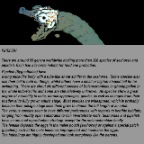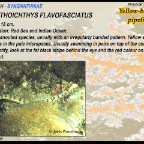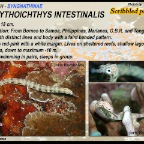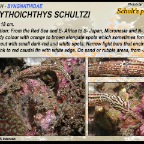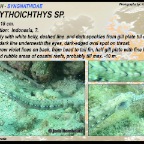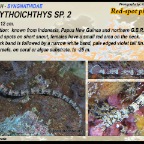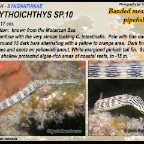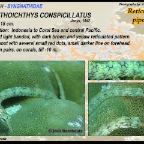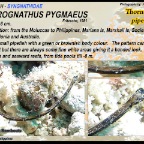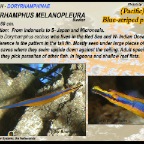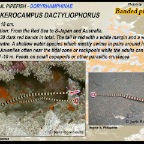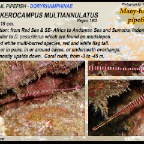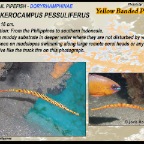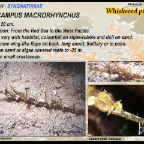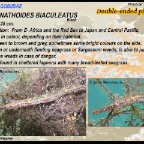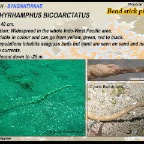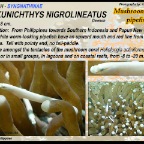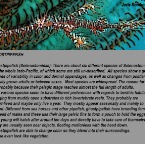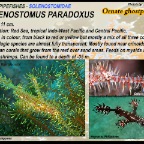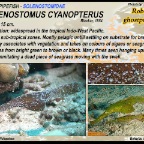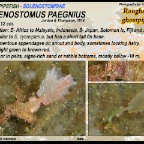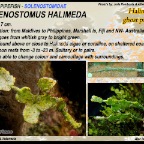Pipefish - Syngnatidae
Pipefish (Sygnathidae) have a long stick-like body with a tube-like snout similar to the seahorse. Some species also use their tail to hold on things, whilst others have a small or big fan-shaped tail fin for swimming. There are about six different species of Solenostomidae or ghostpipefish in the whole Indo-Pacific and some are still relatively unknown. All species show a great degree of variability in color, dermal appendages, gender, as well as changes from their postlarval to fully grown adults stage. Most species are widespread, which is probably because their pelagic stage sees them grow to almost the full length of an adult. The various species seem to have different preferences with regards to benthic habitats, ranging from muddy open substrates to rich invertebrate reefs. Seahorses and pipefish have an unusual reproduction strategy, except for the solenostomidae family. The female deposits the eggs in the males pouch (seahorse) or against a special patch (pipefish), so that the male becomes impregnated and incubates the eggs. The hatchlings are highly developed and look completely like the parents.
GHOSTPIPEFISH
Ghostpipefish (Solenostomidae): There are about six different species of Solenostomidae in the whole Indo-Pacific, of which some are still un-described. All species show a great degree of variability in color and dermal appendages, as well as changes from postlarval to fully grown adults or between sexes. Most species are widespread. The reason for this is probably because their pelagic stage reaches almost the full length of adults. The various species seem to have different preferences with regards to benthic habitats, ranging from muddy open substrates to rich invertebrate reefs. They probably are short-lived and maybe only live a year. They mostly appear seasonally and mainly to breed. Different from sea horses and other pipefish, ghostpipefish have brooding females instead of males and these use their large pelvic fins to form a pouch to hold the eggs in. The young will hatch after around ten days and directly have to take care of themselves. They are usually seen near objects, floating motionless with the head down. They are able to change color so they blend into their surroundings. Some even look like vegetation. Length: 40 cm.Distribution: Widespread in the whole Indo-West Pacific area.Very variable in colour and can go from yellow, green, red to black.Some populations inhabits seagrass beds but most are seen on sand and mud areas, prone to currents. Can be found down to -25 m. Length: 28 cm.Distribution: from E- Africa and the Red Sea to Japan and Central Pacific.Variable in colour, depending on their habbitat. From green to brown and grey, sometimes some bright colours on the side.Mostly in or underneath flooting seagrass or Sargassum weeds, is able to jump ontop of the weeds in case of danger.Usually found in sheltered lagoons with many broad-leafed seagrass. Length: 11 cm.Distribution: Red Sea, tropical Indo-West Pacific and Central Pacific.Variable in colour, from black to red or yellow but mostly a mix of all three colours.Post-pelagic species are almost fully transparent. Mostly found near crinoids or gorgonian corals that grow from the reef over sand areas. Feeds on mysids and benthic shrimps. Can be found to a depth of -35 m. Length: 7 cm.Distribution: from Maldives to Philippines, Marshall Is, Fiji and NW- Australia.A small species with a large head and small caudal(tail) fin. Colour goes from whitish gray to bright green. Mostly found above or close to Halimeda algae or coralline, on sheltered coastal and lagoon reefs from -3 to -23 m. They are able to change colour and camouflage with surroundings. Length: 15 cm.Distribution: Widespread in the tropical Indo-West Pacific.Lives in sub-tropical zones. Mostly pelagic untill settling on substrate for breeding.Primarily associates with vegetation and takes on colours of algaes or seagrasses.This goes from bright green to brown or black. Many times seen hanging upsidedown, immitating a dead peace of seagrass moving with the swell.Length: 8 cm.Distribution: from Philippines towards Southern Indonesia and Papua New Guinea.These white worm-looking pipefish have an upward mouth and red line from mouthtrue eyes. Tail with pointy end, no tail-paddle. They live amongst the tentacles of the mushroom coral Heliofungia actiniformes. Solitary or in small groups, in lagoons and on coastal reefs, from -8 to -20 m. Length: 16 cm.Distribution: from the Philippines to southern Indonesia.Lives on muddy substrate in deeper water where they are not disturbed by waves.Mostly seen on mudslopes swimming along large remote coral heads or anyalternative, like the truck tire on this photograph. Length: 18 cm.Distribution: from the Red Sea to S-Japan and Australia.Around 30 dark red bands in total. The tail is red with a white margin and a white dot in the centre. A shallow water species which mostly swims in pairs around holes and cracks. Juveniles often near the tidal zone or rockpools while the adults can be found to a depth of -10 m. Feeds on small copepods or other parasitic crustacea. Length: 60 cm.Distribution: from Indonesia to S- Japan and Micronesia. Similar to Doryrhamphus excisus who lives in the Red Sea and W- Indian Ocean, the only difference is the pattern in the tail fin. Mostly seen under large pieces of coral or in small caves where they swim upside down against the ceiling. Adult species mostly in pairs, they pick parasites of other fish. In lagoons and shallow reef flats.
Length: 18 cm.Distribution: from E- Africa to S- Japan, Vanuatu, Fiji and N- Australia,?.Pale with dark wavy netted pattern. Around 15 dark bars alternating with a yellow to orange area in between. Spots on snout, lines on head and one in the eyes, white margined pinkish tail fin. Solitary or in pairs, at shallow protected algae and coral reefs or areas with sand or rubble, from -2 to -15 m. Length: 18 cm.Distribution: from the Red Sea and E- Africa to S- Japan, Micronesia and N- Australia.Pale body colour with orange to brown elongate spots which sometimes form lines.Long snout with small dark-red and white spots. Narrow light bars that encircle the body. Pink to red caudal fin with white edge. On sand or rubble areas, from -2 to -15 m. Length: 18 cm.Distribution: from Borneo to Samoa, Philippines, Marianas, G.B.R. and Tonga.Head with distinct lines and body with a faint banded pattern. Tailfin is red-pink with a white margin. Lives on sheltered reefs, shallow lagoons and harbours, down to maximum -10 m. Mostly swimming in pairs, sleeps in group.
Length: 18 cm.Distribution: from E- Africa to S- Japan, Vanuatu, Fiji and N- Australia,?.Pale with dark wavy netted pattern. Around 15 dark bars with a yellow to orange areain between. Spotted snout, lines on head and one in the eyes, white margined pinkish tail. Solitary or in pairs, at shallow protected areas with sand or rubble.From -2 to -15 m. Length: 18 cm.Distribution: Red Sea and Indian Ocean.A short-snouted species, usually with an irregularly banded pattern. Yellow streaksor bands in the pale interspaces. Usually swimming in pairs on top of the corals.To indentify, look at the fat black stripe behind the eye and the red colour on the snout.


